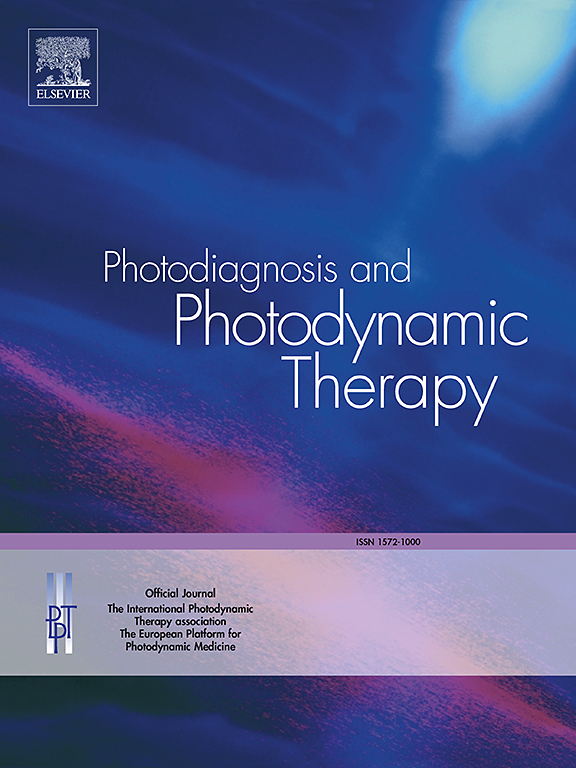体外光动力治疗白色念珠菌,引起外阴阴道念珠菌病,是由芽孢杆菌和肠球菌益生菌增强。
IF 3.1
3区 医学
Q2 ONCOLOGY
引用次数: 0
摘要
背景:白色念珠菌是外阴阴道念珠菌病的主要原因,是世界范围内关注的妇女健康问题。抗菌光动力疗法(aPDT)和益生菌等补充方法的使用,是由于现有抗真菌药物的无效而促进的。方法:本研究考察了益生菌(从发酵泡菜中分离的芽孢杆菌和肠球菌)和PDT(以红色激光(655nm, 18 J/cm2)为光源,亚甲基蓝染料(30 mg/mL)为光敏剂)对白色念珠菌体外毒力活性的联合影响,包括生长、生物膜形成、抗真菌性、生物膜消除和生物膜分散。结果:与真菌细胞相比,益生菌菌株对PDT具有更高的抗性。芽孢杆菌和肠球菌在PDT前和PDT后均增强了PDT对浮游念珠菌细胞的抗真菌作用。与芽孢杆菌(70%)和肠球菌(58%)相互作用后,PDT对生物膜形成的抑制作用增强。与芽孢杆菌(67%)和肠球菌(46%)联合使用后,PDT对念珠菌生物膜的根除率提高。PDT处理后,真菌生物膜的制霉菌素耐药性从(µg/ml) 25降低到6.25,这是由于与两种益生菌的相互作用。在芽孢杆菌和肠球菌菌株存在的情况下,PDT处理后真菌细胞在生物膜上的分散度分别减少了18%和25%。注射真菌/益生菌的幼虫经PDT处理后,其死亡率发生了显著变化。结论:这种协同作用提示使用益生菌/PDT作为外阴阴道念珠菌病的补充治疗。本文章由计算机程序翻译,如有差异,请以英文原文为准。
In vitro photodynamic therapy of Candida albicans, the cause of vulvovaginal candidiasis, is enhanced by Bacillus and Enterococcus probiotics
Background
Candida albicans is the primary cause of vulvovaginal candidiasis, a worldwide health concern for women. The use of supplemental methods, such as antimicrobial photodynamic therapy (aPDT) and probiotics, was promoted by the ineffectiveness of the existing antifungal drugs.
Methods
This study examines the combined effects of probiotics (Bacillus and Enterococcus isolated from the fermented pickles) and PDT (using red laser (655 nm, 18 J/cm2) as a light source and methylene blue dye (30 mg/mL) as a photosensitizer) on the in vitro virulence activity of C. albicans including growth, biofilm formation, antifungal resistance, biofilm elimination, and biofilm dispersion.
Results
The probiotic strains demonstrated a higher resistance to PDT compared to the fungal cell. Bacillus and Enterococcus enhanced the antifungal effects of PDT on planktonic Candida cells in both pre-PDT and post-PDT interactions. The inhibition of biofilm formation by PDT was improved upon interaction with Bacillus (70 %) and Enterococcus (58 %). The eradication of Candida biofilm using PDT was increased after a combination with Bacillus (67 %) and Enterococcus (46 %). The nystatin resistance of the fungal biofilm following PDT treatment was decreased from (µg/ml) 25 to 6.25 due to the interaction with both probiotic strains. Fungal cell dispersion from the biofilm after PDT treatment diminished by 18 % and 25 % in the presence of Bacillus and Enterococcus strains. Galleria mellonella mortality was significantly changed following the PDT of the fungi/probiotic-injected larvae.
Conclusions
This synergistic activity suggests the use of probiotics/PDT as a supplemental treatment for vulvovaginal candidiasis.
求助全文
通过发布文献求助,成功后即可免费获取论文全文。
去求助
来源期刊

Photodiagnosis and Photodynamic Therapy
ONCOLOGY-
CiteScore
5.80
自引率
24.20%
发文量
509
审稿时长
50 days
期刊介绍:
Photodiagnosis and Photodynamic Therapy is an international journal for the dissemination of scientific knowledge and clinical developments of Photodiagnosis and Photodynamic Therapy in all medical specialties. The journal publishes original articles, review articles, case presentations, "how-to-do-it" articles, Letters to the Editor, short communications and relevant images with short descriptions. All submitted material is subject to a strict peer-review process.
 求助内容:
求助内容: 应助结果提醒方式:
应助结果提醒方式:


